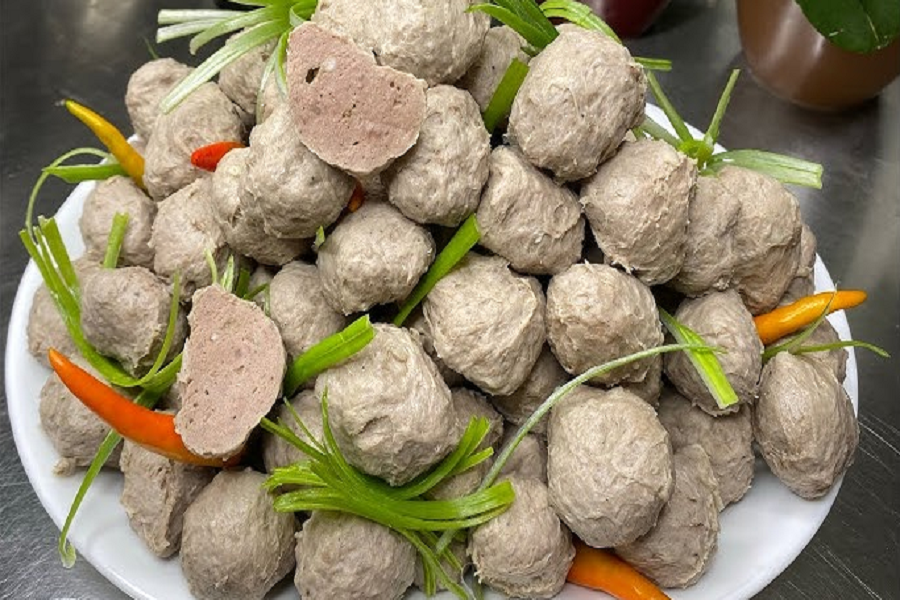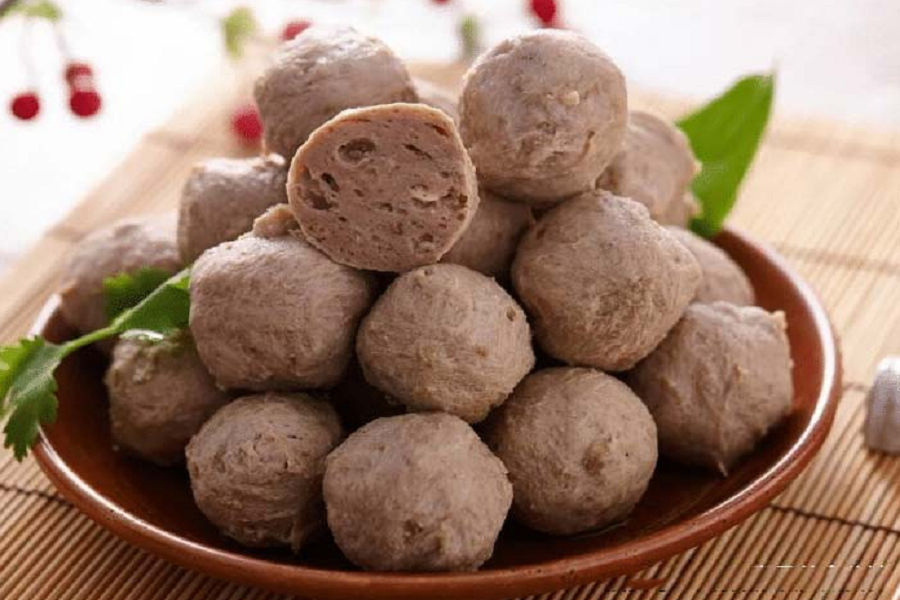Tin tức
Beef patties tendon
Beef tendon patties represent an innovative culinary creation that showcases the unique qualities of beef tendons, a product often overlooked in traditional meat dishes. Beef tendons are fibrous connective tissues found in the joints of cattle, known for their gelatinous texture when cooked. Unlike typical cuts of meat, such as steaks or roasts, beef tendons require a lengthy cooking process to break down their collagen, resulting in a tender, rich consistency that can elevate various dishes.
Introduction to Beef Tendon Patties
The flavor profile of Beef patties tendon is distinct and offers a subtle earthiness that pairs well with a range of seasonings and ingredients. This quality not only enhances the overall taste but also contributes to the dish’s mouthfeel, which is both soft and chewy. Gastronomy enthusiasts appreciate incorporating beef tendon into patties, as it introduces a textural contrast against the backdrop of conventional ground meat patties, thus captivating both the palate and the culinary experience.
Culturally, beef tendon has been a staple in various cuisines around the world, particularly in Asian culinary traditions where it is celebrated in soups and stews. However, its incorporation into modern cooking practices is gaining traction among chefs and home cooks alike. By adapting the traditional notion of a patty, beef tendon patties can now be found in gourmet restaurants and food markets, illuminating the versatility of this often-disregarded ingredient. As food enthusiasts continue to seek out unique and flavorful alternatives, beef tendon patties are emerging as a delicious option, inviting explorers of taste to try something remarkably different.
Health Benefits of Beef Tendons
Beef tendons are a lesser-known but nutritious addition to the culinary landscape, particularly when prepared as beef tendon patties. These tendons are primarily composed of collagen, a vital protein that plays a crucial role in the body’s structural integrity. Collagen is not only abundant in our joints, but it also aids in maintaining skin elasticity, promoting healthy hair and nails, and supporting overall wellness.
The high collagen content in beef tendons can contribute notably to joint health. As individuals age, natural collagen production diminishes, leading to joint pain and stiffness. By incorporating beef tendon patties into one’s diet, which are rich in this essential protein, individuals may experience improved joint function and reduced discomfort associated with conditions like osteoarthritis. Studies have shown that collagen supplementation can lead to an increase in cartilage mass, potentially alleviating joint pain over time.
In addition to joint benefits, the inclusion of beef tendons in meals can significantly enhance skin health. Collagen is vital for maintaining skin structure and elasticity; thus, consuming collagen-rich foods may help reduce the appearance of wrinkles and improve skin hydration. As people seek natural ways to sustain youthful appearance, beef tendon patties serve as a delicious and nutritious option.
Moreover, these patties can easily fit into a balanced diet. They are not only rich in protein but also provide essential amino acids, aiding in muscle recovery and promoting satiety. When paired with a variety of vegetables or whole grains, beef tendon patties can form a well-rounded meal that supports overall health goals.
Ultimately, integrating beef tendon patties into one’s diet offers multiple health benefits, making them a worthy addition for those looking to enhance their nutritional intake while savoring their delicious flavor.

Choosing the Right Ingredients
When embarking on the culinary journey of creating beef tendon patties, the selection of ingredients plays a pivotal role in determining the overall flavor and texture of the dish. Quality beef tendon is arguably the most critical component. Ideal cuts of beef tendon are typically sourced from the lower legs and joints, where the tendons are rich in collagen. This collagen renders the patties tender and juicy after cooking. Ensure that the beef tends to be fresh and well-trimmed, as this will impact the final taste and ensure a pleasant mouthfeel.
In addition to the beef tendon, a well-crafted blend of spices and herbs can elevate the flavors of your patties. Common spices such as garlic powder, onion powder, and black pepper can enhance the savory profile without overpowering the inherent flavors of the tendon. Fresh herbs like parsley or cilantro can introduce a refreshing note, balancing the richness of the beef. For a hint of heat, consider incorporating crushed red pepper flakes or finely diced jalapeños, depending on your taste preferences.
Optional ingredients can also enhance the texture of the patties. Adding breadcrumbs or finely grated vegetables, such as zucchini or carrots, can introduce additional moisture and flavor depth. While these optional ingredients are not necessary, they can provide a unique twist, making your beef tendon patties distinctly yours. When sourcing ingredients, prioritize high-quality options. Local butcher shops are often more reliable for obtaining fresh, well-cut beef tendon than larger grocery chains. This attention to quality will ensure that your patties are not only delicious but also exhibit the unique characteristics that make beef tendon so desirable in culinary applications.
Preparation Techniques for Beef Tendon Patties
Preparing beef tendon patties involves several key steps that ensure the final product is both flavorful and has the right texture. The first step is to select high-quality beef tendons, which are typically found at butcher shops or specialized meat markets. The tendons should be firm and free from any discoloration, indicating freshness.
Begin by thoroughly cleaning the beef tendons. Rinse them under cold water to remove any surface impurities. It is essential to scrape away any residual fat or connective tissue, which can affect the final texture of the patties. To perform this task, use a sharp knife gently, ensuring that you do not remove too much of the tendon itself. Once cleaned, place the tendons in a pot and cover them with cold water. Bring the water to a boil, then reduce the heat to a simmer. Cook the tendons for about 2 to 3 hours, or until they are tender enough to be easily shredded with a fork.
After cooking, drain the tendons and allow them to cool slightly. Once cool enough to handle, chop the tendons into small pieces or shred them as preferred. This will contribute to the texture of the patties. In a mixing bowl, combine the shredded tendons with various other ingredients such as eggs, breadcrumbs, and seasonings. Popular seasonings may include garlic powder, onion powder, salt, and pepper—tailor these to your taste preferences.
Mix the ingredients thoroughly until you reach a consistent mixture. The combination of the tender beef tendons and binding agents like eggs and breadcrumbs will be crucial for the structure of your patties. To shape the patties, take a portion of the mixture and form it into a round, flat shape, ensuring that it is compact enough to hold together during cooking. Aim for an appropriate thickness, typically between half an inch to an inch. This shape will promote even cooking, enhancing the overall texture and flavor of the beef tendon patties.
Cooking Methods: Frying, Baking, or Grilling
The preparation of beef tendon patties can be achieved through various cooking methods, each presenting unique characteristics that can affect flavor, texture, and overall enjoyment. The three prevalent techniques—frying, baking, and grilling—offer distinct advantages and disadvantages that are worth considering.
Frying is often regarded as a favored approach due to its ability to create a crispy exterior while retaining the tenderness of the beef tendon inside. When frying, it is crucial to maintain an oil temperature of around 350°F (175°C) to ensure the patties achieve a golden-brown crust without absorbing excess oil. However, the inherent nature of frying can lead to higher calorie content and potential health concerns associated with excessive fat consumption. Moreover, frying requires constant attention to prevent burning and ensure even cooking.
Baking offers a healthier alternative, allowing for the beef tendon patties to cook evenly without the need for significant amounts of oil. Cooking in an oven at around 375°F (190°C) can yield a pleasantly firm texture and a less greasy finish. Baked patties generally take longer to cook compared to fried ones, usually requiring approximately 25 to 30 minutes. Though the flavor may not reach the same depth as fried patties, adding herbs and spices can significantly elevate the taste, making it a worthy consideration for health-conscious consumers.
Grilling, another viable method, imparts a smoky flavor and pleasant char that many barbecue enthusiasts appreciate. Cooking beef tendon patties on a preheated grill at medium heat (around 400°F or 204°C) typically takes about 6 to 8 minutes per side. Although grilling can elevate the flavor profile, it requires careful monitoring to prevent drying out, as the lean meat can become tough if overcooked. Each of these methods can deliver delectable beef tendon patties, and the choice ultimately depends on personal preference and dietary considerations.
Serving Suggestions and Pairing Ideas
Beef tendon patties are a delightful addition to any meal, offering a unique texture and rich flavor profile that can be enhanced with thoughtful accompaniments. To elevate the dining experience, consider garnishing the patties with fresh herbs such as cilantro or green onions, which add a vibrant color and fresh taste. A sprinkle of sesame seeds can also provide a pleasant crunch, balancing the softness of the patties.
Sauces play an instrumental role in accentuating the flavors of beef tendon patties. A homemade chili sauce, with its spicy kick, is an excellent complement that pairs well with the savory notes of the tendon. Alternatively, a tangy soy sauce-based dip can enhance the umami flavor, making each bite a memorable experience. For those who prefer a creamier texture, a garlic aioli offers a rich, smooth contrast that enlivens the patties.
When it comes to side dishes, consider serving the patties alongside a refreshing slaw. A mix of cabbage, carrots, and a tangy vinaigrette creates a light counterpart to the richer beef tendon patties. Additionally, steamed rice or quinoa can be plated as a hearty base, absorbing the juices from both the patties and accompanying sauces. Roasted vegetables such as bell peppers and zucchini also provide a well-rounded balance, ensuring the meal remains colorful and flavorful.
In terms of beverage pairings, a light lager or a crisp white wine can serve as a refreshing counterpart to the hearty patties. Alternatively, a robust red wine with tannins can complement the richness of the beef, enhancing the overall indulgence. Craft cocktails featuring citrus notes may also provide an interesting contrast, making for a satisfying gastronomic experience.
Cultural Variations of Beef Tendon Patties
Beef tendon patties are a unique dish that transcends cultural boundaries, with each culinary tradition offering its own interpretation through diverse preparation and flavoring methods. In various parts of the world, beef tendons are celebrated not merely for their unique texture but also for their adaptability in different cuisines. This article explores some notable regional variations of beef tendon patties across diverse cultures.
In East Asian cuisine, particularly in countries like China and Korea, beef tendon is often braised until tender, then minced or mixed into patties that showcase umami flavors. Korean-style patties, known as “mandu,” incorporate spices such as garlic and ginger, along with green onions, creating a savory experience that is both aromatic and flavorful. The patties are usually pan-fried or steamed, allowing the rich beef tendon to shine in each bite.
Moving to Southeast Asia, we encounter a variety of dishes that feature beef tendon patties infused with local herbs and spices. In Vietnam, “bánh mì” often serves as a delicious platform for beef tendon, where it is marinated in delectable fish sauces and combined with a mix of fresh cilantro, jalapeños, and pickled vegetables before being enveloped in a crusty baguette. This fusion exemplifies how different communities embrace the versatility of beef tendon while melding it with regional flavors and ingredients.
On the African continent, particularly in North African countries, beef tendon patties may be seasoned with a mixture of spices known as “ras el hanout,” which includes cumin, coriander, and cinnamon. The resulting patty is rich and aromatic, often served with flatbreads or couscous to balance its robust flavors. This variation underlines how cultural contexts can transform a singular ingredient like beef tendon into something distinctly reflective of local traditions.
These regional adaptations of beef tendon patties not only highlight the ingredient’s culinary versatility but also emphasize the global appreciation for this unique culinary delight. As we explore these cultural variations, it becomes clear that beef tendon serves as a common thread, connecting diverse culinary practices through an appreciation of texture and flavor.
Must read articles: Beef patties ba huong da nang
Troubleshooting Common Issues
When embarking on the delightful journey of making beef tendon patties, several common issues may arise that can hinder the desired outcome. It is essential to recognize and troubleshoot these obstacles to ensure a gratifying culinary experience.
One prevalent issue is achieving the right texture. Beef tendon, when properly prepared, offers a unique chewiness that enhances the overall experience of the patties. However, if the tendons are not cooked thoroughly, they may remain tough and rubbery. To remedy this, ensure that the tendons are simmered in a pot of water for an adequate duration, typically around 2 to 3 hours, until they reach tenderness. If you find that your patties are still lacking the desired tender texture, consider incorporating finely minced beef into the mixture to provide additional moisture and help bind the patties.
Flavor balance is another critical aspect to consider while making beef tendon patties. If the seasoning is too weak, the patties may become bland and unappealing. A common solution here is to taste the mixture before cooking. Adding ingredients such as garlic, onion, salt, and pepper can significantly enhance the flavor profile. Moreover, incorporating soy sauce or a touch of sesame oil can introduce a deeper umami flavor, making the patties more enticing.
Lastly, the cooking technique is pivotal. While pan-frying is the most common method, using too high a heat can result in burnt outsides and undercooked insides. Instead, opt for medium heat when cooking your patties, flipping them occasionally to achieve an even and golden-brown result. If you experience any sticking to the pan, consider using a non-stick skillet or adding a small amount of oil to facilitate better cooking. With these solutions at hand, you can ensure that your beef tendon patties are a resounding success.
Conclusion: Embracing the Unique Flavor of Beef Tendons
Throughout this exploration of beef tendon patties, we have highlighted the diverse characteristics that make beef tendons an exceptional ingredient in culinary creations. With their rich, gelatinous texture, beef tendons offer an unparalleled depth to the flavor profile of patties, making them a delightful option for both seasoned chefs and home cooks alike. The process of preparing these patties may require some patience, but the resulting dish rewards this effort with a unique taste experience that is well worth it.
Interestingly, beef tendon patties can be customized to suit various palates, allowing for a multitude of flavor combinations. Whether you choose to incorporate aromatic herbs, spices, or even a variety of dipping sauces, the opportunities for innovation with this ingredient are endless. Such experimentation not only enhances the culinary experience but also allows for a personal touch in the kitchen. By adapting recipes to reflect individual tastes, cooks can create a personal signature dish that is uniquely their own.
As we conclude this exploration of beef tendon patties, we encourage our readers to venture into the world of tendon-based cooking. Whether you are an experienced chef or just starting to explore savory delights, we invite you to try incorporating beef tendons into your recipes. Share your cooking experiences and any variations you create with this remarkable ingredient. Engaging with fellow culinary enthusiasts allows for a vibrant exchange of ideas and techniques, fostering a community rooted in exploration and appreciation of unique flavors. Together, let’s celebrate the versatility and appeal of beef tendon patties in the world of gastronomy.


